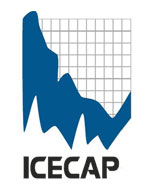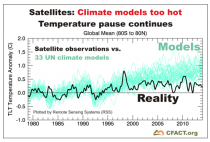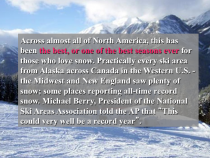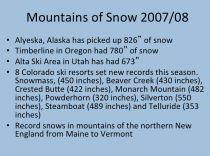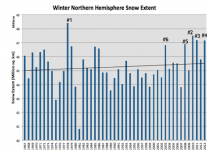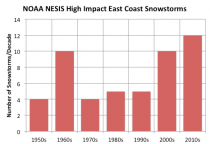A few weeks ago, in mid-January, you would have had a hard time missing the big shouting and celebration in the global warming alarmist camp of 2014 being the “hottest year ever.” As just a few examples, there was Scientific American on January 5 ("2014 Officially Hottest Year On Record"); the BBC on January 16 ("2014 warmest year on record, say US researchers"”; or the New York Times on January 16 ("2014 Breaks Heat Record, Challenging Global Warming Skeptics"). There were plenty of others like those.
If you read all of those articles, without doubt you will come away asking yourself one glaring question, namely: So what did the satellites show? Not one of these articles, or for that matter any of many others from the alarmist camp that I have looked at, so much as mentions the satellite data. But anybody who follows this issue even a little knows that beginning in 1979 the U.S. government at great taxpayer expense has put up satellites with sophisticated instruments to get much more accurate measurements of world temperatures than previously available. The alternative networks of ground based thermometers still exist, but have widely scattered coverage and are subject to large inaccuracies (like from having cities grow up around them, or having their sites moved over the years). So SA, BBC, NYT: How could you insult our intelligence with articles trumpeting “hottest year ever” without telling us what the satellites say?
Luckily it’s not too hard to figure out what the satellites say—their data is published monthly by two sources, UAH and RSS. Here’s an article summarizing the results from both. Of course it’s exactly what you knew it would be as soon as you saw that the likes of the liars at SA, BBC and NYT wouldn’t tell you what the satellites say: 2014 was not the hottest year, nor close, but rather tied for 6th/7th place in the 36 year record from RSS, 0.3 degrees C cooler than the warmest year, which was 1998—16 years ago. Now 0.3 degrees C may not be a lot, but it’s also not a little in a record that only varies by about 1.2 degrees C from coolest to warmest year.
But it gets worse. Regular readers of this blog know that there is a gigantic issue out there of the extent to which the ground thermometer records can be trusted because the guardians of the data (who are the same people putting out the press releases about 2014 being the “hottest year ever") have been systematically tampering with the data to make the earlier years cooler and therefore make the present appear warmer by comparison. I previously wrote about this issue on July 3, 2014 (”What Is The Greatest Scientific Fraud Of All Time—Part II”![]() and on July 19, 2013 (”What Is The Greatest Scientific Fraud Of All Time?”
and on July 19, 2013 (”What Is The Greatest Scientific Fraud Of All Time?”![]() Those articles name names, both of the crooked U.S. government paid fake scientists who “adjust” the raw thermometer data without explanation to fit the desired narrative of “hottest year ever,” and also of the independent researchers who laboriously track down old archived temperature records to uncover the tampering.
Those articles name names, both of the crooked U.S. government paid fake scientists who “adjust” the raw thermometer data without explanation to fit the desired narrative of “hottest year ever,” and also of the independent researchers who laboriously track down old archived temperature records to uncover the tampering.
Just today this issue is starting to explode. It was at the top of Drudge earlier today, although now gradually falling back. Drudge linked to an article by Christopher Booker in the UK Telegraph from Saturday titled “The fiddling with temperature data is the biggest science scandal ever.” (Wait, are they stealing their headlines from me? OK, not quite.) Booker discusses the work of Paul Homewood, reported on his blog notalotofpeopleknowthat. Sample (from Booker):
Homewood has now turned his attention to the weather stations across much of the Arctic, between Canada (51 degrees W) and the heart of Siberia (87 degrees E). Again, in nearly every case, the same one-way adjustments have been made, to show warming up to 1 degree C or more higher than was indicated by the data that was actually recorded. This has surprised no one more than Traust Jonsson, who was long in charge of climate research for the Iceland met office (and with whom Homewood has been in touch). Jonsson was amazed to see how the new version completely “disappears” Iceland’s “sea ice years” around 1970, when a period of extreme cooling almost devastated his country’s economy. See Iceland changes here.
Homewood has also uncovered massive tampering from Paraguay. John Hinderaker of Power Line includes numerous animated GIFs from Homewood demonstrating the data tampering from Paraguay. Homewood adds his work to the extensive output of Tony Heller (who blogs under the name Steven Goddard) of realscience. Heller has uncovered and reported on data tampering at dozens of sites. Just today he reports on Addison, New York. In every instance, whether Siberia, Paraguay, or upstate New York, it’s always the same thing—the past has been cooled to make the present look warmer by comparison. But how could the past somehow have suddenly gotten cooler, 50 or 80 or 100 years after the fact?
Lots and lots of people have demanded an explanation from the guys at NCDC/GISS who put out the adjusted/tampered data and then claim “hottest year ever.” They won’t give any.
So, Scientific American, BBC, New York Times, and all the rest of you who uncritically report the greatest scientific fraud of all time as if it was the truth: When are you going to tell us the real story?
---------
Mercury News editorial: Scientists must solve growing trust problem
Scientists are facing a crisis of trust.
A Pew Research Center poll released Jan. 29 shows a huge gap between the views of scientists and the general public on a range of issues—not just climate change but also genetically modified foods, vaccinations, the use of animals in research and the threat of overpopulation. Furthermore, as scientific theories evolve, today’s instant mass communication of each step forward and back undermines belief in facts that are proven, like the ability of vaccines to all but eliminate a disease.
Lecturing people isn’t the answer. Alan Leshner, the outgoing CEO of the American Association for the Advancement of Science, made that clear Wednesday when he met with this newspaper’s Editorial Board. Scientists instead need to engage the public in a forthright conversation about the importance of science to society, he said.
Thousands of scientists are gathered in San Jose this weekend for the AAAS annual meeting. We hope they’re grappling with how to begin that public conversation. Silicon Valley’s science-based economy should be an inspiration.
Federal funding for R&D in areas such as energy and medicine has dropped 10 percent in the past six years—and these are areas people consider important. Overall, R&D as a percentage of total federal spending is at its lowest level since 1956.
America’s changing attitudes toward science and diminishing funding for research are not entirely a cause-and-effect phenomenon. Americans believe in roads and bridges but don’t want to pay to maintain them, either. And like declining infrastructure, the decline of scientific research and the consequences for Americans’ lives and economic advancement are worrisome.
Increasingly, Americans believe that what’s called science is actually political posturing. For example, only half of the adults surveyed by Pew said climate change is mostly due to human activity, while 87 percent of scientists believe it is; 37 percent of Americans think genetically modified foods are safe, compared to 88 percent of scientists; 68 percent of adults say childhood vaccines should be required, while 86 percent of scientists think so.
And 82 percent of scientists believe world population will be a major problem, while only 59 percent of Americans agree.
In a January editorial in Science magazine, Lesher wrote that only 52 percent of scientists say this “ is a good time for science,” down from 76 percent as recently as 2009. The disparity not only puts future funding for science in danger, Leshner said, but also carries the risk that America’s best young minds will no longer want to pursue research as a career. That would be disastrous for Silicon Valley.
Community and political leaders have a role in restoring respect for the pursuit of scientific truth. But Lesher is right that scientists themselves need to be more engaged in fostering understanding of their independence, motivation and actual work.
By David Rothbard, CFACT
There was nothing special about the temperature of the Earth in 2014. In fact, there has been no meaningful warming since last century.
This is true no matter what set of temperature data you examine.
However, when you examine the data recorded from satellites, the flaws in the warming narrative become even clearer.
Satellites are considered by many to be the best available source of temperature data. Local measurements are subject to many sorts of errors. Temperature stations tend to be located near population centers where they are subject to the urban heat island effect. Weather balloons, temperature stations and buoys leave huge gaps in coverage. Climate researchers then fill in the their best guesses as to what temperature should be for the huge areas where no readings exist. This creates opportunity for honest error - or worse.
Satellites, on the other hand, record temperatures over the entire Earth. Their coverage is more complete and the data they yield is much more difficult to manipulate.
The graph above shows us that there has been no meaningful warming since the 1990’s. Today’s school children have never lived in a warming world.
The graph below shows how badly 33 UN IPCC climate models fare when compared against actual measurements. Keep in mind that the earlier period, when the models and temperatures appear to line up, is from before the models were created.
Hindsight we know is 20/20.
After the models were created, and we were told told the whole thing was settled, global temperatures inconveniently remained cooler than projected.
Go ahead, examine the data for yourself. Compare it to the computer model projections.
That’s what the warming crowd fears most.
The Obama administration’s top environment regulator, after visiting Aspen’s X Games on Thursday, said neither falling oil prices nor Congress will block economic gains to be made by addressing climate change.
But in Colorado, a potentially devastating shift from snow to slush has begun.
“That’s why we’re here. People here do know the climate has changed. It’s been a notable change in how much snow is falling,” Environmental Protection Agency Administrator Gina McCarthy said in a Denver Post phone interview. “If we don’t take action now, that change will be a lot more extreme.”
Surging oil supplies and falling prices will not delay a transition away from fossil fuels in favor of renewable wind and solar energy, McCarthy said. “The work we’re doing with states, to think through our clean-power plan to regulate pollution from power plants, will really provide opportunities for significant investment in renewable energy,” she said.
In Colorado, she stood by Aspen Mountain’s Silver Queen Gondola with Aspen Skiing Co. chief Mike Kaplan and warned that shorter winters and poor snow will hurt business. “Aspen could resemble Amarillo by 2100,” McCarthy said, according to her prepared remarks.
Icecap Note: Amarillo had 12 - 14” of snow this week.
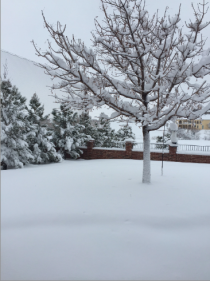
EPA officials calculated that snow-related recreation contributes $67 billion a year to the U.S. economy, supporting 900,000 jobs.
Snowboard stars Gretchen Bleiler and Alex Deibold joined McCarthy at Aspen. The EPA has partnered with the nonprofit Protect Our Winters to enlist athletes and ski industry officials as advocates for climate-change action.
Please contact Bruce Finley: 303-954-1700, bfinley@denverpost.com or twitter.com/finleybruce and tell him where he is going wrong.
Icecap Notes:
2007/08 set all time snow record for much of North America from Alaska to Oregon to Utah and Colorado and Wisconsin to New England.
4 of the top 5 snowiest years for the hemisphere have occurred since 2007/08.
In the eastern US, major metros and ski areas have seen more major snowstorms this decade than any decade since record taking began in the 1950s.
